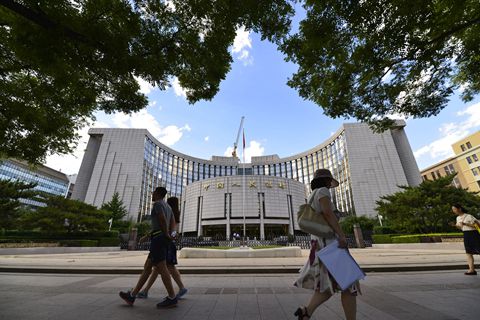PBOC Injects $74 Billion to Bolster Corporate Bond Market

* Monday’s injection came after the central bank offered commercial banks access to MLF loans, especially lenders that invest in lower-rated corporate bonds.
* China Minsheng Bank analyst said he doesn’t consider this quantitative easing, in which a central bank buys bonds directly.
China's central bank injected 502 billion yuan ($73.9 billion) of cash into the banking system Monday through loans to commercial banks, a move to encourage banks to increase lending to small companies and invest in corporate bonds.
The central bank’s injection came at a time when a surge of corporate bond defaults has set investors on edge. China’s $4 trillion corporate bond market has seen a record number of defaults so far this year as tighter credit and rising borrowing costs squeeze overextended companies with weak funding bases.
China Minsheng Bank chief analyst Wen Bin said the move would help to ease the liquidity crunch and prevent a widespread debt default.
Some called the move a Chinese version of quantitative easing, suggesting that policymakers are moving to ease monetary policy as China’s economic growth shows signs of slowing. In the U.S., the Federal Reserve bought trillions of dollars of bonds in pursuing quantitative easing for several years following the 2007-2008 financial crisis.
But Wen said he doesn’t consider the Chinese central bank’s move quantitative easing, in which a central bank buys bonds directly. While using the central-bank loans to purchase corporate bonds, Chinese commercial banks will make the choice of bond investments and assume the risks, not the central bank, he said.
Analysts said the injection indicates China is shifting to looser monetary policy. Ming Ming, fixed income analyst at Citic Securities, said the central bank has gathered its pace to use lending tools to adjust market liquidity since June. Ming expected the liquidity easing to continue for a while.
The People’s Bank of China lent the 502 billion yuan via its one-year medium-term lending facility (MLF) at a rate of 3.3% to commercial banks that purchase corporate bonds this month.
The move was unexpected by market participants as no MLF loans were due to mature on Monday. The central bank usually releases new MLF loans on the day existing loans are to mature.
This was the second MLF injection this month and the most in such an operation since the MLF was introduced in 2014. On July 13, the PBOC injected 188.5 billion yuan of MLF loans when the same amount of existing loans was to mature that day.
An executive at a commercial bank’s financial market department told Caixin that Monday’s injection was the implementation of the PBOC’s window guidance released last week.
Last Wednesday, the central bank offered to provide additional funds to commercial lenders that invest in corporate bonds in a bid to encourage lenders to buy lower-rated corporate bonds to ease a liquidity crunch on small and midsize enterprises.
The executive said banks, upon receiving central bank’s guidance, submitted their lending and bond purchase plans to the central bank, which then would distribute loans to the banks.
Banks that invest in bonds with AA+ ratings and above will get the same amount of MLF loans as the bond investment, while those investing in bonds with ratings lower than AA+ will get twice the amount.
From January to early June, 13 Chinese companies defaulted on 20 corporate bonds with a combined face value of 14.2 billion yuan ($2.11 billion). That was more than half the value of bonds in default over the whole of 2017, according to a report by China Central Depository & Clearing Co. Ltd., a state-owned company that provides depository and clearing services for the domestic bond market.
The central bank’s incentive may be beneficial for bonds issued by local government financing vehicles due to their links to local governments, but it will most likely be less helpful for bonds issued by private companies, according to bond investors.
The MLF loans can be used only by banks’ self-operated business departments to make loans to companies or invest in corporate bonds, and bank’s wealth management departments are not allowed access to the loans, Caixin learned.
A commercial banker told Caixin that banks’ self-operated business departments usually adopt more-conservative investment strategies compared with their wealth management departments and mostly invest in bonds with AA+ ratings and higher.

- 1PDD Fires Government Relations Staff After Fistfight With Regulators
- 2China Ramps Up Effort to Offload Vast Supply of Unsold Homes
- 3China’s Elite-Focused Schools Are Failing Most Students, Top Educators Say
- 4In Depth: China’s Developers Try to Modernize After Surge in Subpar Homes
- 5Cover Story: Trading by Algorithm: Who is Responsible When AI Calls the Shots?
- 1Power To The People: Pintec Serves A Booming Consumer Class
- 2Largest hotel group in Europe accepts UnionPay
- 3UnionPay mobile QuickPass debuts in Hong Kong
- 4UnionPay International launches premium catering privilege U Dining Collection
- 5UnionPay International’s U Plan has covered over 1600 stores overseas






